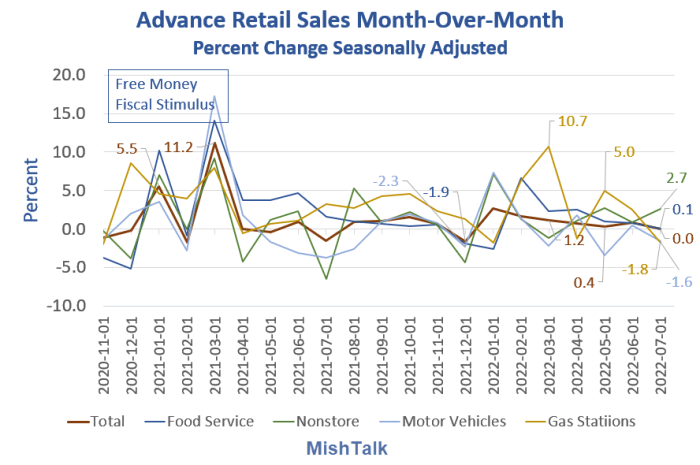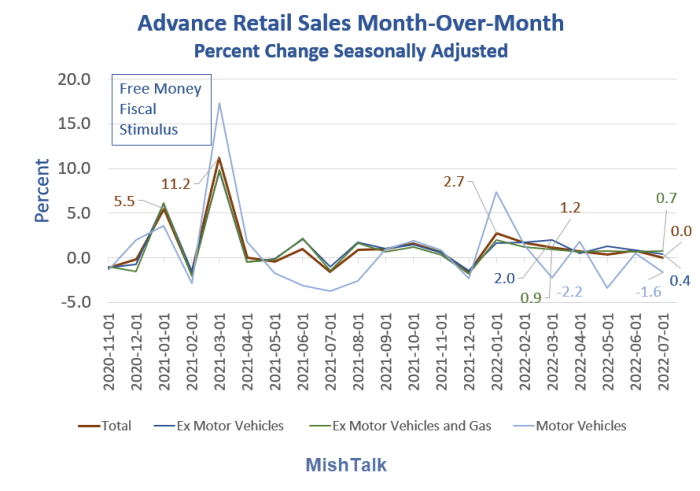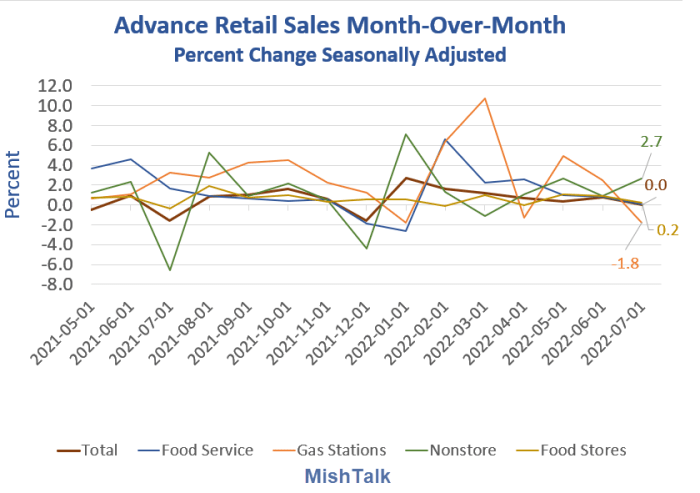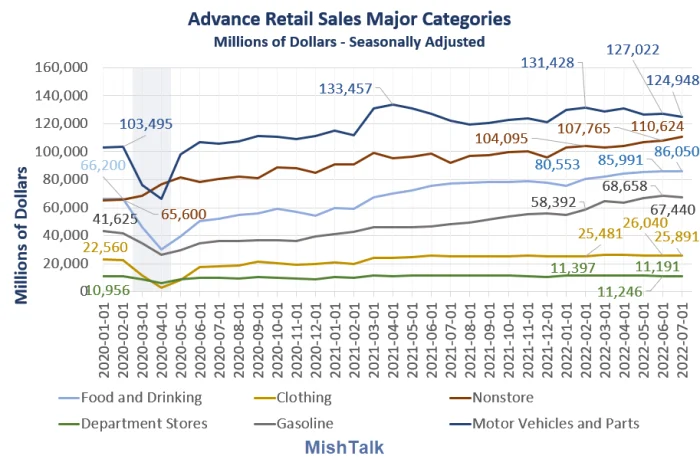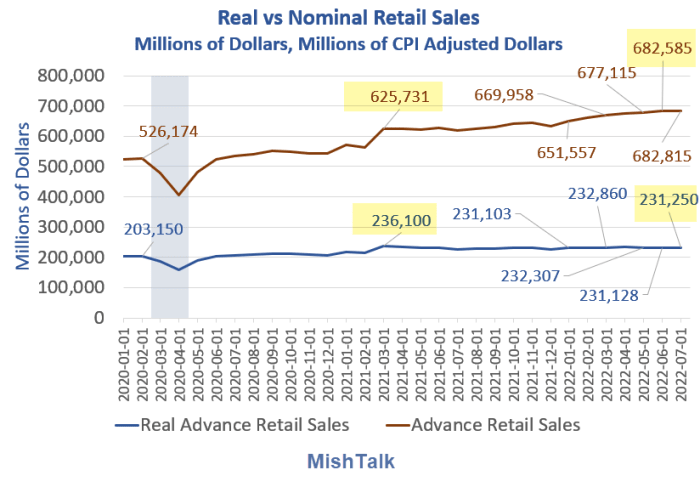Consumers were not the economic savior in July. Motor vehicles account for much of the weakness.
Advance retail sales from BLS, chart by Mish
The Census Bureau reports Retail Sales Were Unchanged in July.
- Advance estimates of U.S. retail and food services sales for July 2022, adjusted for seasonal variation and holiday and trading-day differences, but not for price changes, were $682.8 billion, virtually unchanged from the previous month, but 10.3 percent above July 2021.
- Total sales for the May 2022 through July 2022 period were up 9.2 percent from the same period a year ago.
- The May 2022 to June 2022 percent change was revised from up 1.0 percent to up 0.8 percent. Retail trade sales were virtually unchanged from June 2022, but up 10.1 percent above last year.
- Gasoline stations were up 39.9 percent from July 2021
- Nonstore retailers were up 20.2 percent from last year.
The details sound much stronger than they are. Taking into inflation. retail sales have been declining since March of 2021.
Motor Vehicles Key Weak Point
Motor vehicles and parts sales declined 1.6 percent in July. Excluding motor vehicles, sales rose 0.4 percent. Excluding motor vehicles and gas, sales rose 0.7 percent.
Nonstore Retailers the Big Winner
Nonstore retail sales (think Amazon) jumped 2.7 percent in July, the big winner for the month.
Advance Retail Sales Major Categories
Motor vehicles and parts sales have been weakening all year. Dealers blame lack of part, especially microchips, but chip sales are now floundering.
One problem for the auto sector is dependence on older chips in shorter supply partially due to lower profit margins.
But one has to wonder about high gas prices and recession fears. Even if dealers can get chips, is it now too late. I expected a cyclical decline in durable goods and appliances will be next.
Advance Retail Sales Major Categories Long Term
Consumer spending went haywire due to three rounds of fiscal stimulus. But adjusted for inflation real spending has gone nowhere for a year.
Real vs Nominal Advance Retail Sales
Real vs Nominal Advance Retail Sales Detail
Real vs Nominal Sales Key Points
- Inflation-adjusted, retail sales peaked at 236,100 in in March of 2021 and have generally fallen since then to 231,250 in July of 2022.
- The decline in real sales since March of 2021 is 2.1 percent.
- In nominal terms sales rocketed from 625,731 to 682,585.
- That a nominal rise of 9.1 percent.
With that 9.1 percent rise in sales, one might think GDP would be skyrocketing, but it's real sales that add to GDP not nominal sales.
Inflation has eaten up all of the sales and then some.
The economy is much weaker than most believe. Housing and durable goods sales will lead the decline looking ahead.
Housing Starts Drop 9.6 Percent, Now Below Pre-Pandemic Level, Led By Single Family
Yesterday I reported Housing Starts Drop 9.6 Percent, Now Below Pre-Pandemic Level, Led By Single Family
On Monday, I noted NAHB Sentiment Declines Eighth Consecutive Month Into Negative Territory
Tomorrow we existing home sales. That report rates to be very weak as well.
With housing falling off a cliff, so will demand for durable goods such as appliances, cabinets, lawn mowers, and landscaping. And the Fed is still hiking. Good luck with that.
For further discussion, please see Cyclical Components of GDP, the Most Important Chart in Macro
Also see A Big Housing Bust is the Key to Understanding This Recession
Are we in recession now? I believe so, starting in May, and the data still points that way.
Regardless, it should be pretty clear where we are headed even if a recession has not yet started.
This material is based upon information that Sitka Pacific Capital Management considers reliable and endeavors to keep current, Sitka Pacific Capital Management does not assure that this material is accurate, current or complete, and it should not be relied upon as such.
Recommended Content
Editors’ Picks
EUR/USD: The first upside target is seen at the 1.0710–1.0715 region

The EUR/USD pair trades in positive territory for the fourth consecutive day near 1.0705 on Wednesday during the early European trading hours. The recovery of the major pair is bolstered by the downbeat US April PMI data, which weighs on the Greenback.
GBP/USD rises to near 1.2450 despite the bearish sentiment

GBP/USD has been on the rise for the second consecutive day, trading around 1.2450 in Asian trading on Wednesday. However, the pair is still below the pullback resistance at 1.2518, which coincides with the lower boundary of the descending triangle at 1.2510.
Gold price struggles to lure buyers amid positive risk tone, reduced Fed rate cut bets

Gold price lacks follow-through buying and is influenced by a combination of diverging forces. Easing geopolitical tensions continue to undermine demand for the safe-haven precious metal. Tuesday’s dismal US PMIs weigh on the USD and lend support ahead of the key US data.
Crypto community reacts as BRICS considers launching stablecoin for international trade settlement

BRICS is intensifying efforts to reduce its reliance on the US dollar after plans for its stablecoin effort surfaced online on Tuesday. Most people expect the stablecoin to be backed by gold, considering BRICS nations have been accumulating large holdings of the commodity.
US versus the Eurozone: Inflation divergence causes monetary desynchronization

Historically there is a very close correlation between changes in US Treasury yields and German Bund yields. This is relevant at the current juncture, considering that the recent hawkish twist in the tone of the Fed might continue to push US long-term interest rates higher and put upward pressure on bond yields in the Eurozone.
